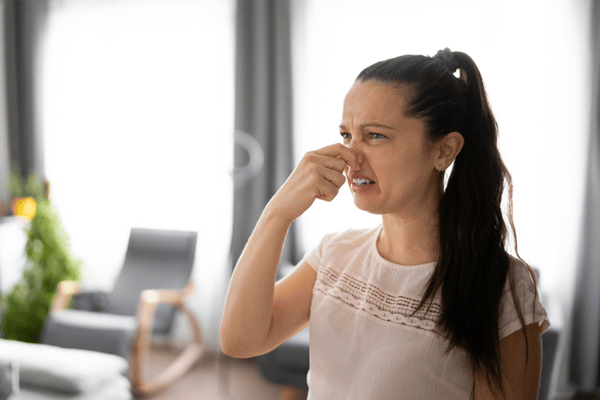If you smell mold in your home but don’t see any visible signs of it, don’t ignore it. That musty, earthy odor is often the first warning sign of hidden mold growth, and addressing it early can save you from expensive repairs and potential health risks.
Mold can lead to respiratory issues, allergies, and even long-term structural damage if left untreated. The good news? With the right strategies, you can track down the source of the problem and take action before it worsens.
This guide will walk you through identifying the mold smell, pinpointing hidden growth, and deciding whether you need professional mold testing.
Could That Musty Smell Be Mold?
We’ve all walked into a space and detected that damp, musty odor. But how can you be sure it’s mold and not just an old, humid environment?
Here’s how to tell if what you’re smelling is mold:
- Mold smells earthy and damp—like wet socks, rotting wood, or stale air.
- The odor lingers and intensifies over time—rather than dissipating like cooking smells or pet odors.
- It’s strongest in certain areas—often in basements, bathrooms, or near HVAC vents.
- The smell worsens after rain or high humidity—which could indicate moisture buildup.
Other causes of musty smells include old carpets, standing water, or mildew, but unlike these, mold will continue to spread unless addressed.
Since mold doesn’t always grow where you can see it, ignoring the smell won’t make it disappear—tracking down the source is essential.
Where Is the Mold Hiding? Common Problem Areas
If you suspect mold, start by inspecting the most common problem areas in your home:
- Bathrooms: Mold thrives in damp, poorly ventilated spaces.
- Basements and crawl spaces: These areas are prone to humidity and leaks.
- Kitchens: Under sinks, around refrigerators, and near dishwashers can hold moisture where mold grows.
- HVAC systems: Mold spores can spread through your home via contaminated air ducts.
- Attic spaces: Poor ventilation or a leaking roof can lead to hidden mold above you.
Since mold needs moisture to thrive, any past water damage—whether from leaks, floods, or condensation—should be a red flag.
How to Investigate When You Smell Mold But Can’t See It
Finding hidden mold requires detective work. Here’s what you can do:
1. Look for Water Damage
- Stains on walls or ceilings (brown, yellow, or gray discoloration)
- Peeling paint or bubbling wallpaper (moisture behind the walls)
- Warped wood or flooring (water damage under the surface)
2. Use a Moisture Meter
A moisture meter (available at most hardware stores) can help detect damp areas within walls or floors, even if mold isn’t visible yet.
3. Perform a Sniff Test
- Close off rooms and track where the mold smell is strongest.
- If the odor worsens when the HVAC system is running, mold could be inside the air ducts.
4. Pay Attention to Health Symptoms
- Increased allergies, headaches, or sinus congestion indoors
- Wheezing, coughing, or breathing difficulties that improve outside
- Skin rashes or eye irritation that worsen in specific areas of the home
If the smell persists but you can’t find the source, it may be time to call in a professional mold inspection.
What to Do If You Find Hidden Mold
If you uncover mold, your next steps depend on its size and severity:
DIY Mold Removal
For small areas (less than 10 square feet), you can remove mold yourself using mild detergent, vinegar, or hydrogen peroxide. Be sure to wear gloves, a mask, and eye protection.
When to Call a Professional
If mold covers a large area, is inside walls, or is present in your HVAC system, professional remediation is necessary. Contact a reliable inspector like Howard Environmental for unbiased mold testing before proceeding with cleanup.
Addressing Moisture Issues
Prevention is key—fix leaks, improve ventilation, and control humidity to prevent regrowth.
Preventing Mold Before It Starts
Mold will return unless moisture problems are resolved.
- Fix leaks immediately – check under sinks, roofs, and appliances.
- Keep humidity below 60% – use dehumidifiers in damp areas.
- Improve ventilation – open windows, install exhaust fans, and clean air ducts.
- Use mold-resistant materials – mold-resistant paint, drywall, and insulation in moisture-prone areas.
- Regularly clean damp surfaces – wipe down showers, sinks, and other humid spots weekly.
Conclusion: Don’t Ignore the Smell—Take Action Now
That persistent musty odor isn’t something to brush off—it’s a warning sign that mold may be lurking in your home. Addressing it early can protect your family’s health and save you from costly repairs down the line.
Not sure where the smell is coming from?
Contact Howard Environmental for a professional, no-nonsense mold inspection. Owner Will Rivers believes in honest assessments without upselling unnecessary services. His team specializes in accurate, impartial mold evaluations, so you get the facts you need to act confidently.
Schedule an inspection today and breathe easy knowing your home is mold-free!
Howard Environmental | Serving Austin, Bee Cave, Cedar Park, Georgetown, Round Rock, Leander, and Pflugerville
Call us today for expert mold testing!

